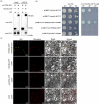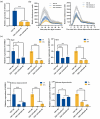Alternaria solani Effector AsCEP20, Essential for Virulence, Targets Potato StFtsH4 Protein to Suppress Plant Disease Resistance
- PMID: 40518751
- PMCID: PMC12167767
- DOI: 10.1111/mpp.70109
Alternaria solani Effector AsCEP20, Essential for Virulence, Targets Potato StFtsH4 Protein to Suppress Plant Disease Resistance
Abstract
Alternaria solani is an important necrotrophic pathogen causing potato early blight. However, the pathogenic molecular mechanisms of A. solani remain unclear. Previous work identified a specific effector AsCEP20 in A. solani through multi-omics analysis. AsCEP20 is required for the full virulence of A. solani and targets the host chloroplasts. In this study, we screened out 46 candidate proteins that potentially interact with AsCEP20 in Nicotiana benthamiana using co-immunoprecipitation followed by liquid chromatography-tandem mass spectrometry analysis. We identified a candidate target protein in potato, filamentation temperature-sensitive H4 (StFtsH4), which is located in chloroplasts, based on homologous alignment and subcellular localisation analysis. The interaction between AsCEP20 and StFtsH4 was further confirmed by co-immunoprecipitation, yeast two-hybrid assay and bimolecular fluorescence complementation assays. The interaction site between AsCEP20 and StFtsH4 is also the chloroplast. Silencing the potato StFtsH4 gene resulted in suppressed pathogen-associated molecular pattern-triggered reactive oxygen species (ROS) bursts, and defence-related genes were significantly downregulated. These results suggest that StFtsH4 positively regulates plant immunity. Therefore, AsCEP20 targets the chloroplast protein StFtsH4 to promote pathogen infection. AsCEP20 attenuates the efficiency of light energy utilisation in photosynthesis by targeting StFtsH4. These results suggest that AsCEP20 suppresses StFtsH4-mediated potato disease resistance to A. solani. With the increase of light intensity, ROS continued to accumulate in the chloroplast of StFtsH4-silenced plant leaves, while defence-related genes significantly decreased. Our findings reveal that the impaired StFtsH4 function limits plant photosynthesis, thereby affecting immune signalling.
Keywords: Alternaria solani; chloroplast; effectors; plant–pathogen interaction.
© 2025 The Author(s). Molecular Plant Pathology published by British Society for Plant Pathology and John Wiley & Sons Ltd.
Conflict of interest statement
The authors declare no conflicts of interest.
Figures







References
-
- Bessadat, N. , Berruyer R., Hamon B., et al. 2017. “ Alternaria Species Associated With Early Blight Epidemics on Tomato and Other Solanaceae Crops in Northwestern Algeria.” European Journal of Plant Pathology 148: 181–197.
-
- Brabandt, H. , Bauriegel E., GRber U., and Herppich W. B.. 2014. “ФPSII and NPQ to Evaluate Bremia lactucae‐Infection in Susceptible and Resistant Lettuce Cultivars.” Scientia Horticulturae 180: 123–129.
-
- Chang, J. , Mapuranga J., Wang X., et al. 2024. “A Thaumatin‐Like Effector Protein Suppresses the Rust Resistance of Wheat and Promotes the Pathogenicity of Puccinia triticina by Targeting TaRCA.” New Phytologist 244: 1947–1960. - PubMed
MeSH terms
Substances
Grants and funding
LinkOut - more resources
Full Text Sources

